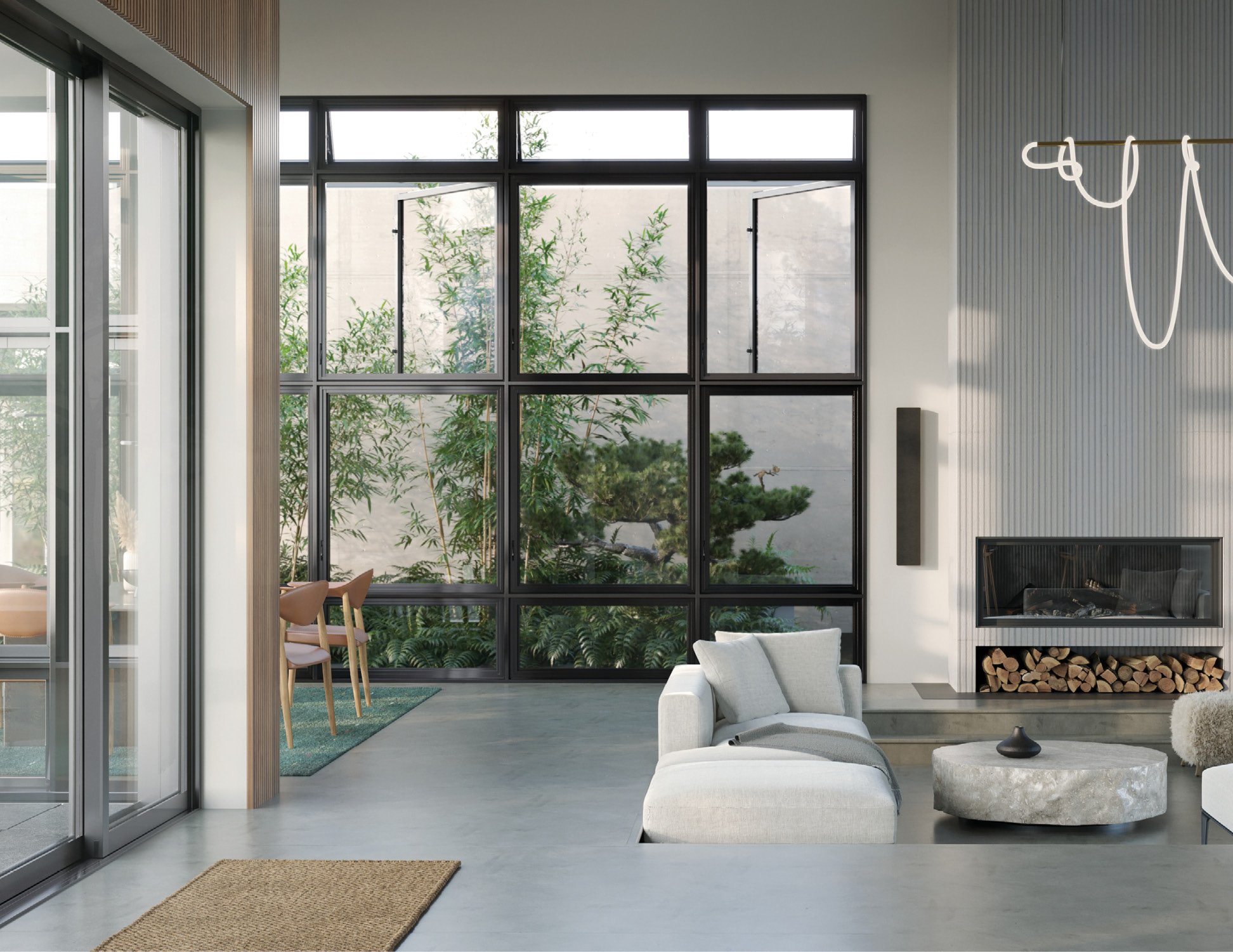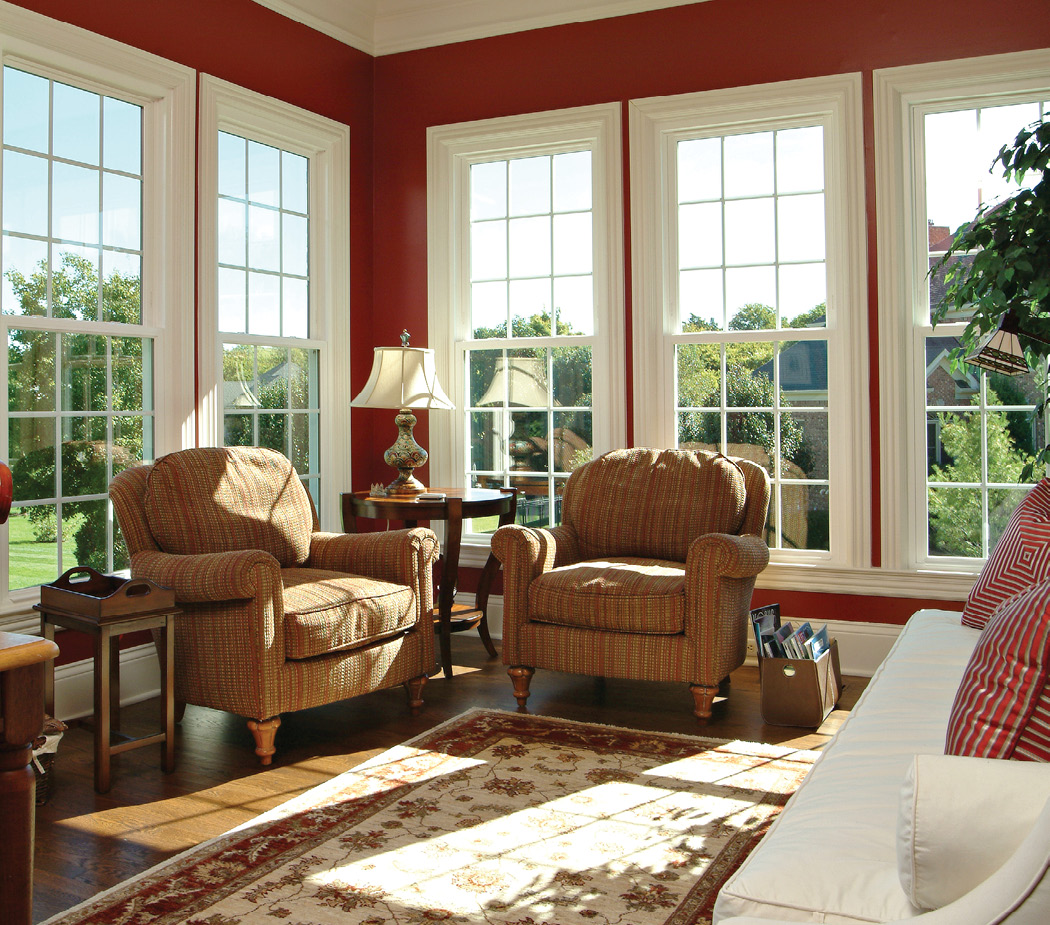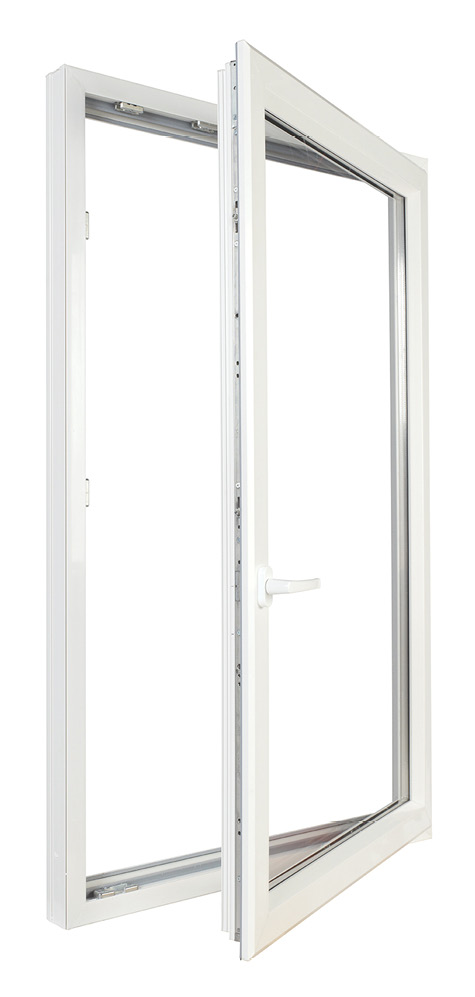
Above: Mavin’s Connected Home platform allows homeowners to operate skylights, windows and doors through a smart home platform. Product lines offering this technology include Modern Automated Awning and Casement windows (pictured), Awaken skylights and the Modern Automated Multi-Slide door. Photo courtesy of Marvin Windows & Doors
Windows encompass many roles in a home. They provide a view of the outside, protect against the elements and help maintain a home’s interior comfort. They contribute in no small way to a home’s design aesthetic. A homeowner may not notice a great window every day, but they surely will notice every day if windows aren’t meeting their expectations.
Window type, performance and design attributes, and other considerations factor into the equation of what window is right for a home.
A double-hung market
“The U.S. is still predominantly a double-hung market; that’s the workhorse of the American window manufacturing companies,” says Patrick Goodrich, chief operating officer, Seaway Manufacturing Corp. “It’s a great design that offers the homeowner a lot of flexibility with how they can interact with the product, ventilate their home and make cleaning easier.”
A similar aesthetic, single-hungs often go into new construction because of the product’s lower price point (the exception being design-build projects, says Goodrich. Homeowners looking to replace windows generally transition to double-hung products and frequently consider casement windows for over the kitchen sink, says Goodrich.
Most replacement window customers replace like for like, observes Goodrich. “Mostly people have a good interaction or bad interaction with a type of product,” he says. “We typically see changes when the homeowner is changing all of the windows. But if someone is going to do just five windows per year in their 20-window house, they really can’t make changes and jump product type.”
Michael Wandschneider, director of product development at Marvin, agrees. “Most homeowners choose the same window types as what they are replacing. In some circumstances, fixed windows will be added in place of operating windows. In other instances, ergonomic or accessibility considerations will impact the selection of window types,” he says.

What’s old is new again
Design constantly fluctuates, whether it be European or traditional American colonial millwork. “Old becomes new again,” says Goodrich. “What was hot in the 1980s seems to be coming back around now.” Color, of course, is a continuing part of window design and can be co-extruded, laminated or painted. See the sidebar on p. 35 for a dive into finishes for aluminum-framed systems.
Wandschneider says home design drives window types more than the region. “Double-hung and single-hung windows skew more traditional; casements, awnings and gliders lean more contemporary,” he says. “Broadly speaking, larger direct-glaze and picture windows are growing in popularity across all market segments.”
Window manufacturers also must be cognizant of performance requirements across the country. Erie, Pennsylvania-based Seaway, for example, services as far west as Wisconsin, and along the eastern seaboard from Massachusetts down to Alligator Alley in Florida. “Inside those areas, there are different structural requirements and variability in the thermal requirements. Focusing on the design of the products first allows us to participate in those markets and give the homeowner the most tailored solution for their area,” says Goodrich.
“Fixed windows—direct-glaze or picture—are generally most efficient. However, they cannot open and do not provide fresh air. For operating windows, casement and awnings outperform hung windows and gliders,” says Wandschneider, noting every window type has nuances to maximize efficiency and comfort.
Tilt and turns

European products are gaining more share in the U.S. In this year’s Industry Pulse report, Greg Koch, vice president of sales and marketing, Deceuninck North America, shared, “We see an increase in demand for high-performance European platforms for commercial applications, such as our tilt-and-turn windows. In fact, European manufacturers are now importing to the U.S., focusing on the East Coast. These products are moving out of the niche category in the U.S. and becoming much more visible and sought after.”
Koch further explained the increasing awareness of tilt and turn windows in North America, largely driven by the profile’s energy-efficiency attributes due to its compression sealing and multi-point locking. “It’s virtually impossible to beat that kind of performance,” he says.
As market awareness has increased, some eastern European countries with lower manufacturing costs have distributed windows to the U.S. at what Koch calls a “competitive price,” ultimately opening the market more. Importing products, however, brings the challenges of a long supply chain. That all has led to some U.S. manufacturers adopting tilt and turns, which Koch describes as a “big win” for customers. “Your lead times can be lower and your service can be better if something arrives broken at the jobsite,” he explains.
Koch shares a bit about Deceuninck’s process of bringing the product to the U.S.—a process its European roots have helped with. Deceuninck began with its Revolution product, an Americanized tilt-and-turn platform, which it then enhanced and evolved into the RevolutionXL. “That was based on European design, where we North Americanized the application,” he says. The North American frame is 3 ¼ inches deep and has an integral nailing fin and installation strap groove.
Energy efficiency really drives the tilt and turn market. Deceuninck’s Elegant platform, which uses ThermoFibra technology that embeds a fiberglass bar into the PVC extrusion for structural reinforcement and thermal efficiency, is piquing customer interest, says Koch. Such technology takes an already high-end product to the next level, further appealing to customers.
Despite the industry's increasing awareness of tilt and turns, it remains a super-niche product. Koch estimates it represents maybe a percentage point of the entire market. “The market is growing faster than the general window market, but it’s still small,” he says.
Tilt and turn generally appeals more to the North American commercial market, too, for several reasons, including the price point and functionality. Because tilt and turns open to the inside, it complicates residential window treatments. European wall thickness is substantially deeper than in North America; when the window tilts in, it still stays inside the wall cavity. Here, however, the wall depth is shallower, causing the window to hit shades, drapery or other window treatments. Insect screens also complicate it. “Generally, these products aren’t designed with screens in mind,” Koch says.
Manufacturing considerations
Although the popularity of double-hung products remains relatively static, the manufacturing process continues to evolve. Goodrich shares that Seaway has invested in new equipment to enhance its existing capabilities and increase efficiencies. “Many of our design processes are much more millwork-like with a lot of curves and features that were traditionally hard to clean,” he says. “We’ve brought in automation that allows us to have a repeatable, effective process.”
“Marvin’s use of automation is primarily focused on the safety of our teams,” says Wandschneider. “As windows and doors continue to increase in size and scale, we leverage automation to make manufacturing and handling increasingly safe. We also look at how automation can simplify processes with technology and data, pairing its impact with Marvin’s product offerings.”
The general process of cutting, welding and cleaning remains the same through manufacturing window profiles, says Goodrich. The variability comes into play when addressing aesthetics, performance values and the different stations needed to transform raw material into the specified product. Seaway trains its staff in similar processes on different lines. For example, similar saws can perform cutting among the different production lines, and operators are trained to move back and forth between the saws in case someone is out. “We build in that flexibility and focus on training our people and the quality drive so everybody knows every step in the process,” he says.
Tilt and turns comprise three elements that ease manufacturing: the frame, sash and glazing bead. “They’re all easy to weld, easy to work with, and process and create the drainage and other functionality you need in the system,” explains Koch. “With hardware, the European groove is designed so the hardware is almost self-locating and easy to install, which takes a lot of the error and quality risk out of the product.”
As the trend of large windows continues, tilt and turns’ size is limited only by the functionality of hardware and how much weight they can handle. Further considerations for size include whether the unit is double- or triple-glazed, the hardware, and the glass package. “There are different size sashes and reinforcements you can bring to a tilt-turn, so there are many variables,” says Koch.
Automated hardware is another opportunity for tilt and turn products. They’re easier to automate compared to hungs or sliders, according to Koch. “With the tilt-turns, it’s fairly simple in that the same mechanism can tilt the sash, open it, bring it back together again and close it,” he explains.
